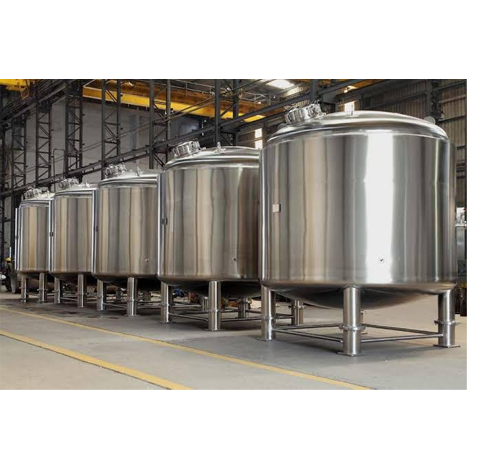- GST Number - 27AADCB6508L1ZI
WFI Storage Tanks
How to use WFI Storage Tanks?
- Preparing the tank: Before using the WFI storage tank, ensure that it has been cleaned, sanitized, and validated according to the standard operating procedures (SOPs) of the facility. The tank should also be inspected for any visible signs of damage or contamination.
- Filling the tank: To fill the tank with WFI, ensure that the source of water is purified and meets the required standards. The WFI is typically supplied through a dedicated WFI distribution system that is connected to the tank. The flow rate and volume of the WFI should be monitored to ensure that the tank is not overfilled.
- Maintaining the tank: Once the tank is filled, it should be maintained to ensure that the WFI remains at the required quality. This involves monitoring the temperature, pH, conductivity, and microbial count of the WFI in the tank. Any deviations from the required specifications should be investigated and addressed immediately.
- Dispensing the WFI: When WFI is required for use in a manufacturing process, it can be dispensed from the tank through a dedicated WFI distribution system. The flow rate and volume of the WFI should be carefully controlled to ensure that the required amount is dispensed and that there is no risk of contamination.
- Cleaning and sanitizing the tank: After use, the tank should be cleaned and sanitized according to the facility's SOPs to ensure that it is ready for the next use. The cleaning and sanitization procedures should be validated and verified to ensure that they are effective in removing any traces of WFI and preventing microbial growth.
Applications of WFI Storage Tanks:
- Production of sterile injectables: WFI is an essential component in the production of sterile injectables, which are used to administer medication directly into the bloodstream. WFI is used as a solvent, diluent, and carrier for many drugs and is required to be of high quality to ensure the safety and efficacy of the final product.
- Manufacturing of biologics: Biologics are complex molecules produced from living cells and are used to treat various diseases, including cancer and autoimmune disorders. WFI is used in the manufacturing process of biologics to ensure that the water used to make the products is free of impurities that could affect the quality and safety of the final product.
- Cleaning and rinsing equipment: WFI is used to clean and rinse equipment used in pharmaceutical manufacturing processes to prevent contamination of the products. WFI is used as a final rinse after cleaning with detergents and disinfectants to ensure that any traces of cleaning agents are removed.
- Quality control testing: WFI is used as a reference standard in quality control testing to ensure that the water used in pharmaceutical manufacturing processes meets the required specifications. WFI is used to calibrate instruments used to test the quality of the water, such as pH meters, conductivity meters, and microbial testing equipment.
- Other applications: WFI is also used in other pharmaceutical manufacturing processes, such as the production of vaccines, diagnostic reagents, and medical devices. WFI may also be used in research and development activities, such as cell culture and microbiological testing.
Sailent features of WFI tanks :
- Material of construction: WFI tanks are typically made of high-quality stainless steel (316L or 316Ti) to ensure that the water is not contaminated by the tank material. The stainless steel used in the construction of WFI tanks is of pharmaceutical grade and is polished to a smooth surface finish to prevent the buildup of bacteria and other contaminants.
- Design and construction standards: WFI tanks are designed and constructed according to industry standards and regulations, such as the US FDA (Food and Drug Administration) and European Pharmacopoeia. The tanks are designed with features that prevent contamination, such as sloping bottoms, smooth interior surfaces, and dedicated WFI distribution systems.
- Validation and qualification: WFI tanks are subject to rigorous validation and qualification procedures to ensure that they meet the required standards and specifications. This involves testing the tanks for cleanliness, integrity, and resistance to corrosion and other forms of degradation.
- Size and capacity: WFI tanks come in various sizes and capacities, depending on the needs of the facility. The size and capacity of the tank should be chosen based on the anticipated demand for WFI and the available space in the facility.
- Quality control monitoring: WFI tanks are equipped with monitoring systems that measure the temperature, pH, conductivity, and microbial count of the water stored in the tank. The monitoring systems are connected to alarms and automatic shut-off systems to alert personnel if there are any deviations from the required specifications.
- Cleaning and maintenance: WFI tanks are designed for easy cleaning and maintenance to ensure that the water stored in the tank remains of high quality. The tanks are typically fitted with CIP (Clean-In-Place) systems and other features that facilitate cleaning and sanitization.
Get a Free Quote





